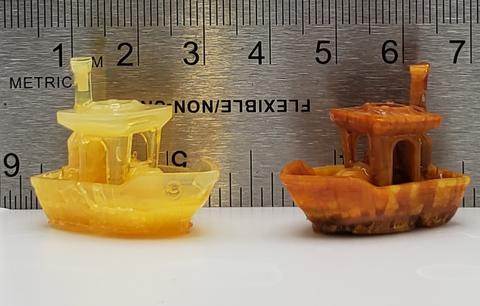Spotlight: Toot, Toot! NIST Innovation in 3D Printing Takes a Familiar Form for the Industry

Do you know Benchy the Boat? NIST researchers certainly do, and the 3D-printing design is helping them make waves with a technique called vat photopolymerization.
To start off, Benchy (a nickname for “benchmark”) isn’t a NIST original work of art. More commonly referred to as #3DBenchy, the third-party, open-source design has been around for almost a decade, and many in the 3D-printing world have tested their machines with it. That’s because the boat contains challenging features for printers to overcome, such as pillars and overhangs.
Those features are especially challenging when using resins such as the one NIST researchers are working with.
Polyelectrolyte complexes (PECs) are resins with properties that make them potentially useful in fire protection, food packaging, drug delivery, insulation and more. They can erode in a water solution and are sometimes even biodegradable.
Now, for the first time, our researchers used PECs with a branch of additive manufacturing called vat photopolymerization. It’s a technique that uses light to solidify a liquid resin, layer by layer, into a 3D-printed shape.
As you can see here, the team 3D-printed the resin into none other than Benchy the Boat. They were able to control the sensitivity of PECs to water, making one version of Benchy that could degrade quicker than the other.
Then, to top it off, they took the dissolved remains of our boat friend and recycled them into a new part. This might sound cruel, but remember … this is not a person or even a boat. It’s a science project.
The results show a lot of promise for both the future of PECs and our hopes for a more circular economy. Find the full details in this paper, published via Advanced Science News.
Follow us on social media for more like this from all across NIST!

